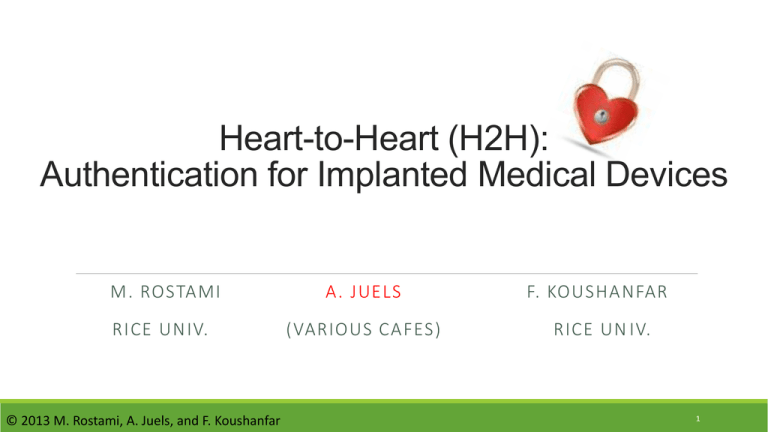presentation
advertisement

Heart-to-Heart (H2H): Authentication for Implanted Medical Devices M. ROSTAMI A. JUELS F. KOUSHANFAR RICE UNIV. (VARIOUS CAFES) RICE UN IV. © 2013 M. Rostami, A. Juels, and F. Koushanfar 1 What’s an IMD? •Implanted Medical Devices (IMDs) are surgically implanted systems that monitor physiological conditions and (usually) apply therapies. •Pacemakers •Cardiac defibrillators •Neurostimulators •Drug-delivery devices •25 million people in U.S. alone fitted with IMDs 2 What’s an IMD? •Medical devices branching into many areas; someday, most people may have one •Example: Transcranial Direct Current Stimulation (tDCS) •Improves cognitive performance •(May also prevent migraines) 3 Why do we need to secure IMDs? •IMDs are embedded systems •Microprocessors •Batteries •Wireless interfaces •Why wireless? In order to •Update firmware, programming •Provide telemetry •Communicate with other IMDs (eventually) 4 Two big dangers to IMD users 1. IMD access is too easy • Landmark attack by Halperin et al. in 2008 (UMass, UW, BI) • The case of former U.S. VP Dick Cheney • He has a heart • He has a pacemaker (IMD) • He was assassinated when his pacemaker was hacked over the air… thankfully only on TV • In real life, revealed two weeks ago to have disabled pacemaker wireless in 2007 over concerns about hacking 5 Two big dangers to IMD users 1. IMD access is too easy • Landmark attack by Halperin et al. in 2008 (UMass, UW, BI) • The case of former U.S. VP Dick Cheney • He has a heart • He has a pacemaker (IMD) • He was assassinated when his pacemaker was hacked… • In real life, revealed two weeks ago to have disabled pacemaker wireless in 2007 over concerns about hacking 6 Two big dangers to IMD users 1. IMD access is too easy 2. IMD access is too hard • E.g., Patient collapses on sidewalk • EMTs arrive and try to read diagnostics / reprogram IMD • They can’t get access… • (They can’t remember their first pets’ names) How do we address these conflicting challenges for emergency access to IMD? 7 Some previous work • Conventional password / device key? • 2010 U.S. Dept. of HHS report: medical errors may be third leading cause of death • Password or key-based access to IMDs would be a key-distribution nightmare • • Physical processes, e.g., magnets [HKH-BF+08] Ultraviolet Micropigmentation Tattoos [S10] • • • Distance-bounding [RCH-BC09] • • • Nice approach Power considerations, hardware modification, various attacks Wearing a shield or jammer around the neck [GHRK+11] • • Clever and probably workable May not meet patient acceptance, may be hard to find, lacerations? Can violate FCC rules, inconvenient Transmitting key via Piezo device [HH-BRC+08] • Our approach in H2H: Measurement of Physiological Values (PVs) (EKG) 8 Heart-to-Heart (H2H): setting and approach • Two devices: • IMD • Programmer • Access-control policy: Touch-to-access • Protocol in H2H 1. Programmer sensor touches patient’s body 2. IMD reads PV A 3. Programmer reads PV B 4. Devices check that A ≈ B B ? = A Programmer 9 Authentication using physiological values • Earliest mention of approach: Patent filed by RSA in 2008 • Not implemented; few details • Two published schemes (EKG): • F. Xu, et. al., "Securing implantable medical devices with the external wearable guardian," INFOCOM 2011. • C. Hu, et. al., "OPFKA: Secure and efficient ordered-physiological-feature-based key agreement for wireless body area networks," INFOCOM 2013 • Slightly different settings than IMD emergency access • Both schemes shown vulnerable to cryptanalytic attack: • M. Rostami, W. Burleson, A. Juels, and F. Koushanfar, “Balancing security and utility in medical devices?” DAC, 2013. 10 Heart-to-Heart (H2H): What do EKG data look like? •EKG measures electrical activity in body, reflecting activity of heart •R peak is the most prominent EKG feature •We examine R-R interval (heart-beat duration) 11 Heart-to-Heart (H2H): What do EKG data look like? •R-R interval is also called the inter-pulse interval (IPI) •Underlying processes have well-studied chaotic nature •IPI is a good source of entropy (used in previous work) 12 How much entropy? • We analyze some standard EKG databases (MIT-BIH, PTB, and MGH/MF) • IPIs are normalized, quantized, and Gray-coded, yielding 8-bit value • We take error between left hand & right hand as surrogate for that between IMD and Programmer, i.e., between A and B… 13 Heart-to-Heart (H2H): entropy source • Effectively have common, secret source of entropy for IMD and Programmer • It outputs a 4-bit random value x1x2x3x4 with every heartbeat • IMD and (honest) Programmer tap this source over (slightly) noisy channel • IMD reads A, Programmer reads B x1x2x3x4 Programmer 14 Heart-to-Heart (H2H): entropy source •Of course, four bits aren’t a lot •We can measure multiple IPIs to harvest more entropy • Default in H2H: (n=15, 11-15 secs.) x1x2x3x4 Programmer 15 Challenge 1: How to compare A and B? •IMD should only give access to Programmer if A ≈ B •But how close should A and B be? •Previous schemes just look at Hamming distance between A and B •But the error rates are non-uniform across bits •E.g., x1 has 8% error rate, while x4 has error rate of 0.9%! •This naïve approach throws away entropy! •Our approach: Use Neyman-Pearson Lemma 16 Challenge 1: How to compare A and B? Neyman-Pearson Lemma: •For PV u: •Let P(u) be probability adversary (no skin contact) makes guess u for true PV •Let Q(u) be probability valid Programmer/IMD yields u for true PV •There exists an threshold T such that an optimal classifier accepts a reading u as valid if log (P(u) / Q(u)) > T 17 Challenge 1: How to compare A and B? Neyman-Pearson criterion: log (P(u) / Q(u)) > T • • • Conveniently, bits x1x2x3x4 are unbiased and independent Paper contains a number of tricks for implementing NeymanPearson Lemma efficiently in IMD We benefit from full entropy of source in comparing A ≈ B 18 Challenge 2: How to compare A and B securely? • Idea 1: Have Programmer send B to the IMD and compare A and B on IMD • An adversary can intercept and replay B • How to compare A and B without exposing them on unauthenticated channel? • Ideal 2: Use a Password-Based Key Agreement (PAKE) protocol (e.g., [KOY01]) to establish a secure channel between the IMD and Programmer • PAKEs require A=B, and we have A≈B • What we need is a fuzzy PAKE • We could use fuzzy crypto (e.g., JW99, DORS04) • Incurs entropy loss • No clear way to integrate into PAKE • General secure function evaluation too expensive for embedded devices 19 Challenge 2: How to compare A and B securely? Key observation: Entropy source changes continuously, so A and B treatable as one-time secrets! • • We can expose A and B at end of protocol We can use commit / decommit approach Second observation: We can bootstrap protocol with unauthenticated secure channel SecChannel • In practice, this means TLS without a certificate 20 H2H protocol overview IMD Programmer SecChannel (TLS)s Read A CA Commit(A,wA;s) CA Read B CB Commit(B,wB;s) CB wA A ≈ B ??? ✔ wB A ≈ B ??? Prototype implementation: Design choices •Design objective 1: Minimal power consumption on IMD •SecChannel: Low exponent RSA-based TLS (e = 216+1) with IMD as client •Design objective 2: Stronger security than ordinary 8-digit (e.g., SecurID) authentication token •Read n = 15 IPIs (11 to 15 secs.) •FAR, FRR < 3 x 10-9 •Design objective 3: No hardware modification to existing IMDs 22 Power-consumption profile ARM-Cortex M-3 microprocessor 23 Do we really get touch-to-access policy? •I.e., is skin contact by Programmer required to read IPIs clearly? •Photoplethysmography (PPG) • Subtle changes in skin color due to heart • Our experiments show it isn’t a viable attack •Head movements? •Capacitive sensing? •Ripley’s-Believe-It-or-Not attack • EKG can be read via EEG of someone you shake hands with [BBMG13] 24 A lot more work to do… •More detailed security analysis •Remove idealized SecChannel? •Extract more entropy from EKG for protocol? •Using H2H with other PVs • EEG? EMG? •Sensing attacks against touch-to-access? 25 Conclusions •Heads of state shouldn’t have to deactivate IMD features •Today, though, it’s perhaps prudent to do so •H2H offers touch-to-access authentication policy using EKG •Doesn’t require hardware modification to existing IMDs, e.g., pacemakers •IMD authentication is an important and interesting problem at physical / logical security boundary 26







